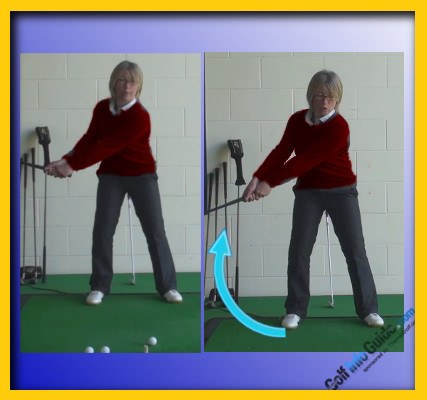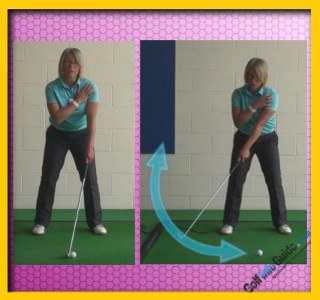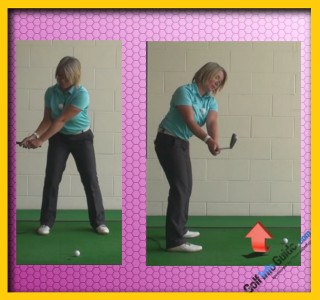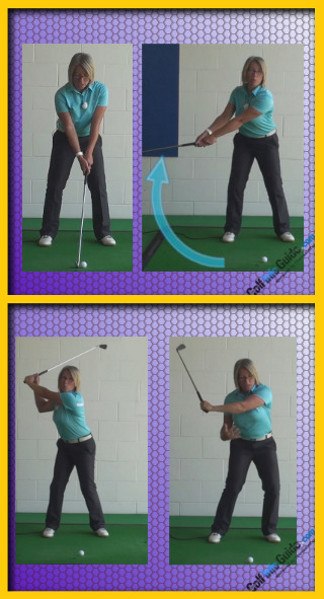
A good golf setup should position a straight front arm and a straight golf club shaft in a nice, strong line. A good golf backswing should use this straight line as a guide to creating a wide one piece takeaway.
A good powerful takeaway creates a wide arc and sets the path of the club on the right curve. Any over use of the hands, forearms or legs in the takeaway move can result in a breakdown and a lack of connection throughout the entire swing.
In order to create your perfect, wide takeaway, try to feel that your lead shoulder is the first and only thing to move at the start of your swing. As you rotate your lead shoulder, the shaft and front arm should stay as one piece, and in line, until around hip level.
After hip level on the back swing, the wrists and forearms can play a bigger part in picking and lifting the club to the top of the backswing. However, try to avoid making your hands and arms too active in the first part of your swing.
The correct movement is particularly helpful under pressure when often golfer's hands and forearms can become too active in the takeaway, resulting in inconsistent and poorly struck golf shots.
The longer the club you use, the lower, slower and wider your arc should feel. Therefore, the driver is the lowest, slowest and widest arc of all of your swings. If you're using your wedges for pitching and chipping, the need for a straight front arm and shaft line decreases and hand action can be applied earlier in the backswing move for more feel and a steeper takeaway.

Wide Takeaway Keep Lead Arm in Line with Shaft
The takeaway sets the stage for the rest of your golf swing. It is easy to overlook the takeaway while focusing on other parts of the swing such as the transition and impact, but that would be a mistake. It is extremely difficult to hit good shots after starting your swing with a poor takeaway, so be sure to give this part of your technique the attention it deserves. If you are willing to invest even a small amount of time in refining the mechanics of your takeaway, you can expect to see great improvements in the quality of your swing as a whole.
Generally speaking, a wide takeaway is a good takeaway. Of course, there is more to the takeaway equation than just width, but keeping your swing as wide as possible in the early stages is a great place to start. Width that is created early in the swing often translates to power that will be created later on, so focus on a wide takeaway if you would like to maximize your distance potential. Narrow backswings usually cause nothing but trouble, which is why you will rarely see a professional golfer who lacks width going away from the ball. Nearly every top player around the world takes advantage of what is gained by a wide takeaway, and you should do the same.
The great thing about working on your takeaway is the fact that this part of your technique does not change from one shot to the next, or from one club to the next. The fundamentals that you work on in the takeaway apply all throughout your bag, so this is work that will pay off during each swing that you make from the first hole to the last. In terms of getting a return on your time 'investment' when practicing, you can't do much better than spending time working on building a proper takeaway.
In the content below, we are going to review the benefits of using a wide takeaway, and we will also get into the details of how you can add this element to your own swing. A wide takeaway such as the one described below is also known as a 'one-piece takeaway', which is a term you may have heard from time to time in golf circles. If you are currently in the habit of making a narrow takeaway and backswing, the change to a wider motion may take some time to master – but it will be worth your effort in the end. There are many benefits to using this kind of action at the start of your swing, and there are almost no drawbacks to speak of. Rarely in golf will you get the chance to add an element to your swing which is all 'pros' and no 'cons', so you should jump at this opportunity to get better.
All of the instruction below is based on a right handed golfer. If you happen to play left handed, please take a moment to reverse the directions as necessary.

The Benefits of a Wide Takeaway
This might go without saying, but you only want to include elements in your swing if they are going to help you achieve a positive outcome with each shot. Many golfers have movements within their swinging action that serve no purpose at all – or, they have movements which actually serve to hurt the overall swing. The best golfers have swings which are simple and easy to repeat – and each move has a specific purpose and goal in mind.
So, before you go out to work on adding a wide takeaway to your swing, it is important that you understand exactly why this move is so desirable in the first place. Once you have a clear picture of what a wide takeaway can do for your game, you will be even more motivated to put it into place.
- Set the course. The most important thing you can do in your takeaway is trace a good path for the club to use when it comes back down into the ball. The club head is likely to retrace its path from the backswing when it comes down toward impact, so be sure you are setting yourself up for a great move at the bottom of your swing. Many golfers take the club away dramatically to the inside or outside of the intended swing path, and they are never able to get back on track as a result. With a wide takeaway, you should find that it is relatively easy to trace a good line as you go back – meaning you should have no trouble tracing that same line when you eventually come through the ball.
- Start out with great rhythm. A wide, one-piece takeaway is an excellent way to create rhythm and timing in your swing. Many amateurs rush through the takeaway by using their hands and wrists to move the club – and they never get the club swing matched up with their body rotation as a result. When you sweep the club back slowly, however, your shoulders will remain right over top of the club as it moves, and everything will be timed up beautifully at the top of the swing. Tempo is a big part of playing good golf, and you can go a long way toward improving yours simply by making a wide takeaway.
- Establish a shallow plane. For most of the shots you hit during a round, you are going to want to come into the ball on a relatively shallow plane. That means that the club head is moving along the ground for at least a few inches before it contacts the ball and slides into the turf to take a divot (with your irons). Steep swings – those that come down sharply from above – usually result in inconsistent ball flights, high spin rates, and overall poor outcomes – are only useful from time to time in specific situations. When you use a wide takeaway, you will find that you are setting the club up for a shallow approach into the ball when it comes back down toward impact.
- Consistency. Moves you make with the big muscles in your body are going to be more consistent than those made with your small muscles – which is why a wide takeaway is more consistent than a narrow one. A narrow takeaway will require you to use your hands and wrists – which contain some of the smallest muscles in your body. On the other hand, a wide, sweeping takeaway is controlled mostly by your shoulders and torso, where some of your largest muscles are located. Most golfers will quickly notice an improvement in the consistency of their swing after adding a wide takeaway to the start of the action.
As you can see, there is a lot to like about using a wide takeaway in your swing. All of the points above stand as potential benefits when you use this technique, and there are others that you may find which aren't even mentioned on the list. Regardless of which specific benefits you find to be the most helpful in your own game, you can be sure that adding a wide takeaway to your technique is something that will point you in the direction of improved performance on the course.

Making It Happen
Now that you know why you should be making a wide takeaway, you need to learn exactly how you can put this technique into place in your own swing. The good news is that it is actually relatively easy to make a wide takeaway, once you know what you are trying to do. On the other hand, you will have to break your habit of making a narrow takeaway first, and that can be a bit of a challenge. Like anything else in golf, you will only succeed in making this adjustment if you are willing to work hard and see the process through to the end.
To get started, you first need to make sure that your address position is in good condition. Without a great address position, it will be hard to anything right – including the takeaway. Some of the important points that should be included in your address position include the following –
- Feet roughly shoulder width apart with your center of gravity located right in the middle of the stance
- Slight degree of flex in your knees
- Your chin should be up off of your chest, but your eyes should be looking down at the ball
- Your arms should be hanging freely from your sides, with tilt at the waist allowing you to reach the ball comfortably
There is no point in even working on your takeaway before you have your address position under control. A poor address position will leave you fighting an uphill battle in the swing, and you will lose that battle more often than not. If you aren't happy with your current address position, spend some time working on it until you feel that you have be able to move your body into a good spot over the ball.
Now that your address position is taken care of, it is time to actually learn how to make a good takeaway. To do so, please follow the simple steps below –
- Prior to starting your swing, make sure you have a clear target in mind. This is an important step that is overlooked by many golfers – without a clear target in mind, your swing will lack direction and you will basically be hoping that the ball winds up close to the hold.
- With your target in mind and your stance taken, now is the time to start moving the club back away from the ball. To do so, focus all of your attention on your left shoulder. Rather than moving the club with your hands or your arms, you are going to move it by beginning to rotate your left shoulder to the right. Everything else about your posture should stay perfectly steady while your shoulder turns away from the target. This is why it is important to have your chin up off of your chest as was mentioned earlier – because your shoulder needs room to pass under your chin on the way back.
- While completing the takeaway, you should notice that your lead arm (the left arm) is staying nicely in line with the shaft of the club. This is a result of letting your shoulders do the work in the takeaway. If you were to rely on your hands and wrists to move the club away, the line between your left arm and the club shaft would quickly be broken. If you would like, you can practice making your takeaway in front of a mirror so you can easily see if you are maintaining that line nicely throughout the takeaway. As long as the line doesn't break, you can be confidence that the basics of your takeaway are in good condition.
- Of course, you will need to break that line eventually as you get farther into the backswing. As a general rule of thumb, you want to try to keep your hands out of the swing until the the club reaches a point where it is parallel to the ground. At that time, you can feel free to start hinging your wrists in order to take the club the rest of the way to the top. Once the club hits that parallel to the ground point, you can consider the takeaway to be complete and you can move on with the rest of your swing.
As far as golf swing instruction goes, it doesn't get much easier than this – keep the left arm in line with the shaft of the club and turn to the right. That's it. While the rest of the golf swing can be somewhat complicated at times, the takeaway is beautifully simple. In fact, the fastest way to mess it up is simply to do too much. As long as you limit yourself to a controlled rotation of your left shoulder away from the target and under your chin, it is hard to go wrong.

Triggering the Swing
As you can now see, the takeaway is incredibly simple to perform properly. As long as you are willing to spend a bit of time working on the short process outlined above, you should be able to get the physical side of the takeaway under control in short order. However, there is still the mental side of the equation to consider. As you know, golf is a game that is just as much mental as it is physical, so you have to be sure you are thinking correctly as your swing gets started.
The biggest mental hurdle that relates to the takeaway is the moment just before the swing is supposed to start. Many golfers – perhaps even yourself – get 'stuck' at this point. With everything in place and ready to go, some players just can't seem to get themselves to actually start the swing. This is a problem that has even taken victims within the professional ranks, so it isn't necessarily tied to the ability of the player. If you find that you are having trouble getting your mind to convince your body to start the swing, you need to address that issue right away. This is a problem that is only going to get worse without intervention, and it could reach a point where you can't even play at all.
So, if you are having trouble pulling the trigger as you stand over the ball, the first thing you should do is review your pre-shot routine. A good pre-shot routine will give your mind something to focus on as you prepare to swing – which is great for allowing you to 'get out of your own way'. If you are thinking carefully about how to get ready to hit the shot, you might not even have time to freeze up out of fear or doubt. Review your pre-shot routine to make sure that it includes everything you need to in order to get ready to hit a shot.
After you have gone over your routine, the next thing you can do is to add in a 'false start'. What does that mean? Basically, a false start is like a practice takeaway. You move the club back a few inches as if you were starting your swing, only to return it to its position behind the ball. You have probably seen this move used by some of the pros, and it can certainly be helpful for the average golfer as well. This addition to your routine is a great way to take the pressure out of the takeaway, because you will have the chance to make a practice takeaway before you start 'for real'. After you complete one repetition of practice with your takeaway, you should find that starting your swing up the next time to actually hit the shot is no problem at all.
One last tip that you can use if you are still struggle with this issue is to limit the amount of time that you are standing over the ball. While you don't want to rush through the shot, taking too much time can often lead to feeling like your body is stuck in place. Shorten up your routine so that your swing gets started quickly after you have taken aim and built your stance – working at a quick pace is a great way to get over the fear of starting your takeaway once and for all.

A Short Game Exception
For the most part, the concept of using a wide, one-piece takeaway is something that translates nicely into the short game. You certainly want to move your shoulders together with the club while putting, and you can think about your chipping takeaway in much the same way as you think about the takeaway for your full swing. Therefore, the progress that you are making with your takeaway while hitting long shots should help you perform better on and around the greens as well.
However, there is one exception – greenside bunker shots. When playing from the sand around the green, you will need more hand action in the shot than you can get from a one-piece takeaway. Sand shots are often seen as requiring the opposite technique from the full swing, and that is certainly the case with the takeaway. Rather than maintaining the line between your left arm and your club shaft as you swing back, you will want to engage your wrists almost immediately when the swing starts. Using your hands and wrists to move the club will give the club head elevation and speed, two things which are required when trying to hit nice explosion shots.
Since the explosion shot from the bunker is so much different from the rest of your swings, it is important that you practice it on a regular basis. If your local course has a practice bunker somewhere around the driving range, make it a point to hit at least a few sand shots as part of each practice session. It shouldn't take too long before you are comfortable with the idea of using a different takeaway in the sand than you are using around the rest of the course.
In all, a wide takeaway should be a great thing for your golf game. Once you learn how to make a wide, one-piece takeaway, you will notice that your shots have more power and are more-frequently on target. Of course, a good takeaway isn't going to solve all of the problems that may be present in your swing, but it is a great place to start. Think of the takeaway in your swing like the foundation under a house – a foundation doesn't complete the house, but the house won't stand without it. Put in some time and effort to polish up your takeaway before moving on to other parts of your swing technique.






